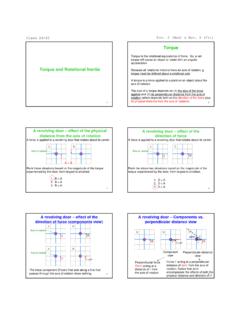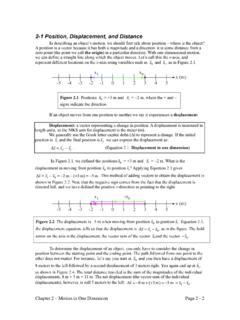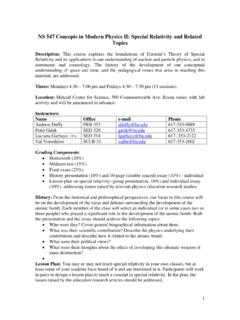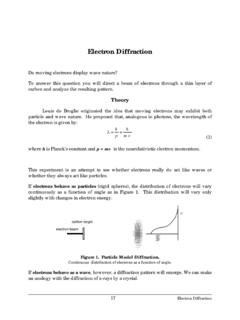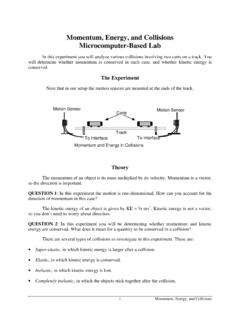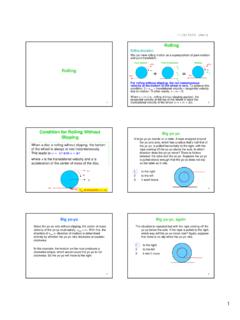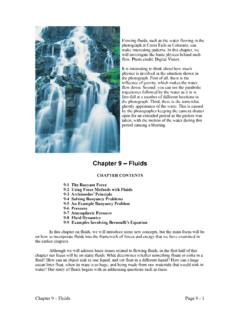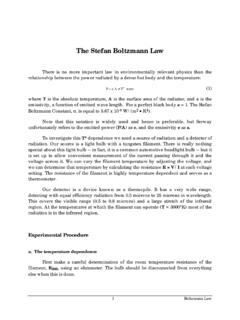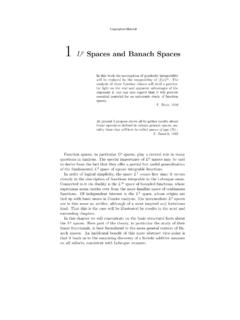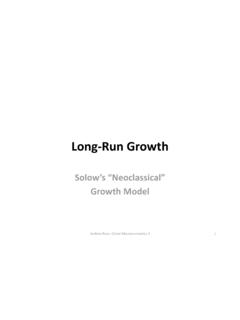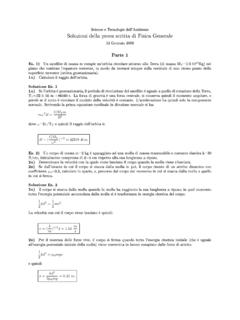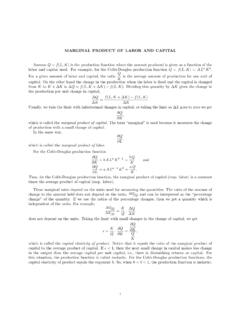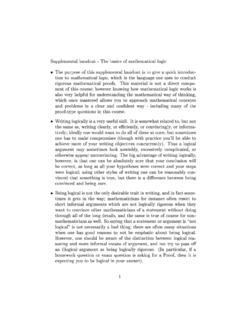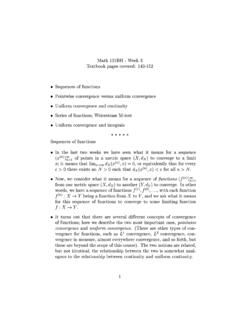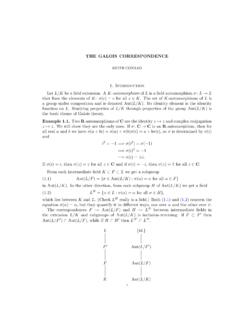Transcription of FourierSeries - Boston University Physics
1 Fourier Series and IntegralsFourier SeriesLetf(x) be a piecewise linear function on [ L, L] (This means thatf(x) may possessa finite number of finite discontinuities on the interval). Thenf(x) can be expanded in aFourier seriesf(x) =a02+ Xn=1ancosn xL+bnsinn xL,(1a)or, equivalently,f(x) = X cnein x/L(1b)withcn= (an ibn)/2n <0(an+ibn)/2n >0a0/2n= useful schematic form of the Fourier series is~f(x) =Xn(an cn+bn sn).(2)This emphasizes that the Fourier series can be viewed as an expansion of a vector~finHilbert space, in a basis that is spanned by the cn(cosine waves of different periodicities)and the sn(sine waves).To invert the Fourier expansion, multiply Eq. (1) by cosn xLor sinn xLand integrateover the interval. For this calculation, we need the basic orthogonality relation of the basisfunctions:ZL Lcosn xLcosm xLdx= mnL,(3)and similarly for the sin s.
2 Intuitively, forn6=m, there is destructive interference of thetwo factors in the integrand, while forn=m, there is constructive by multiplying Eq. (1) by cosn xLand integrating, we obtainZL Lf(x) cosm xLdx=ZL L"a02+ X1ancosn xL+bnn xL#cosm xLdx,(4)from which we findan=1 LZL Lf(x) cosn xLdx.(5a)Similarly, thebn s may be found to bebn=1 LZL Lf(x) sinn xLdx.(5b)1 The inversion of the Fourier series can be viewed as finding the projections of~falong eachbasis direction. Schematically, therefore, the inversioncan be represented as~f cm=Xn(an cn+bn sn) cm=Xan nm=am,(6a)which impliesam=~f cn.(6b)These steps parallel the calculation that led to Eq. (5). This schematic representationemphasizes that the Fourier decomposition of a function is completely analogous to theexpansion of a vector in Hilbert space in an orthogonal basis.
3 The components of thevector correspond to the various Fourier amplitudes definedin Eqs. (5a) and (5b). Wave2L3L-L-2L0hLf(x)xClearlyf(x) is an odd function:f(x) = f( x). Hencean=1 LZL Lf(x) cosn xLdx= 0 nAs a result, the spectral information of the square wave is entirely contained in thebn coefficients arebn=1 LZL Lf(x) sinn xLdx=2hLZL0sinn xLdx=2hn (1 cosn ),from which we findbn=n4h/n the square wave can be written as a Fourier sine seriesf(x) =4h sin xL+13sin3 xL+15sin5 xL+ .(7)There are a number of important general facts about this expansion that are worth em-phasizing: Sincef(x) is odd, onlyoddpowers of theantisymmetricbasis functions At the discontinuities off(x), the Fourier series converges to the mean of the twovalues off(x) on either side of the discontinuity. A picture of first few terms of the series demonstrates the nature of the convergenceto the square wave; each successive term in the series attempts to correct for the overshoot present in the sum of all the previous termsone termtwo termsthree termsten terms The amplitude spectrum decays as 1/n; this indicates that a square wave can bewell-represented by the fundamental frequency plus the first few harmonics.
4 By examining the series for particular values ofx, useful summation formulae maysometimes be found. For example, settingx=L/2 in the Fourier sine series givesf(x=L/2) =h=4h sin 2+13sin3 2+15sin5 2+ and this leads to a nice (but slowly converging) series representation for /4: 4= (1 1/3 + 1/5 1/7 + 1/9 ).Alternatively we may represent the square wave as (x)Nowf(x) = +f( x). By symmetry, then,bn= 0 n, and only thean s are these coefficients we findan=1 LZL Lf(x) cosn xL=2 LZL0f(x) cosn xL=2hL"ZL/20cosn xLdx ZLL/2cosn xLdx#=2hn "Zn /20cos tdt Zn n /2cos tdt#=2hn hsin t|n /20 sin t|n n /2i= 4hn ( 1)(n 1) (x) can be also represented as the Fourier cosine seriesf(x) =4h cos xL 13cos3 xL+15cos5 xL .(8)This example illustrates the use of symmetry in determininga Fourier series,even function cosine seriesodd function sine seriesno symmetry both sine and cosine seriesThus it is always simpler to choose an origin so thatf(x) has a definite symmetry, so thatit can be represented by either a sin or cosine ParabolaThis is the periodic extension of the functionx2, in the range [ , ], to the entire real any function defined on the interval [a, b], the periodic extension may be constructedin a similar fashion.
5 In general, we can Fourier expandanyfunction on a finite range; theFourier series will converge to the periodic extension of the 3 3 The Fourier expansion of the repeated parabola givesbn= 0 na0=1 Z x2dx=2 23an=2 Z 0x2cosnx dx= ( 1)n4n2 Thus we can represent the repeated parabola as a Fourier cosine seriesf(x) =x2= 23+ 4 Xn=1( 1)nn2cosnx.(9)Notice several interesting facts: Thea0term represents the average value of the function. For this example, thisaverage is non-zero. Sincefis even, the Fourier series has only cosine terms. There are no discontinuities inf, but first derivative is discontinuous; this implies thatthe amplitude spectrum decays as 1/n2. In general, the smoother the function,the faster the decay of the amplitude spectrum as a function ofn. Consequently,progressively fewer terms in the Fourier series are needed to represent the waveformto a fixed degree of accuracy.
6 Settingx= in the series gives 2= 23+ 4 Xn=1( 1)nn2cosn from which we find 26= Xn=11n2 This provides an indirect, but simple, way to sum inverse powers of the integers. Onesimply Fourier expands the functionxkon the interval [ , ] and then evaluates theseries atx= from whichP n=1n kcan be computed. The sumP n=1n z (z),is called the Riemann zeta function, and by this Fourier series trick the zeta functioncan be evaluated for all positive integer values summary, a Fourier series represents a spectral decomposition of a periodic waveforminto a series of harmonics of various frequencies. From the relative amplitudes of theseharmonics we can gain understanding of the physical processunderlying the waveform. Forexample, one perceives in an obvious way the different tonal quality of an oboe and a origin of this difference are the very different Fourier spectra of these two if the same note is being played, the different shapes of the two instruments(string for the violin; air column for the oboe) imply very different contributions of higherharmonics.
7 This translates into very different respective Fourier spectra, and hence, verydifferent musical IntegralsFor non-periodic functions, we generalize the Fourier series to functions defined on[ L, L] withL . To accomplish this, we take Eq. (5),an=1 LZL Lf(x) cosn xLdkand now letk=n /L n dk. Then asL , we obtainA(k) anL=Z f(x) coskx dx(10a)and, by following the same procedure,B(k) bnL=Z f(x) sinkx dx(10b)Now the original Fourier series becomesf(x) =Xnancosn xL+bnsinn xL=XnA(k)Lcoskx+B(k)Lsinkx 1 Z k=0A(k) coskx dk+B(k) sinkx dk.(11a)By using the exponential form of the Fourier series, we have the alternative, but morefamiliar and convenient Fourier integral representation off(x),f(x) =1 2 Z f(k)eikxdk.(11b)Where the (arbitrary) prefactor is chosen to be 1/ 2 for convenience, as the same pref-actor appears in the definition of the inverse Fourier transform.
8 In symbolic form, theFourier integral can be represented as~f=Xcontinuous sum onkfk find the expansion coefficientsf(k), one proceeds in precisely the same manner as inthe case of Fourier series. That is, multiplyf(x) by one of the basis functions and integrateover a suitable range. This givesZ f(x)e ik xdx=1 2 Z Z f(k)ei(k k )xdx dk(12)However, the integral overxis just the Dirac delta function. To see this, we writeZ ei(k k )xdx= limL ZL Lei(k k )xdx=2 sin(k k )Lk k (13a)The function on the right-hand side is peaked atk=k , with the height of the peak equalto 2L, and a width equal to /L. AsL , the peak becomes infinitely high and narrowin such a way that the integral under the curve remains a constant. This constant equals2 . Thus we writeZ ei(k k )xdx= 2 (k k )(13b)Using this result in Eq. (12), we obtainf(k) =1 2 Z f(x)e ikxdx(14).
9 Schematically,~f ek =Xk~fk ek ek fk=~f developments can be extended in a straightforward wayto Wavef(t) = 1|t|< T /20|t|> T ( ) =1 2 ZT /2 T /2ei tdt=T 2 sin T /2 T /2.(15)f(t)T1tf( ) T1/T7 Notice that there is an inverse relationship between the width off(t) and the width ofthe corresponding Fourier transformf( ). The Fourier spectrum is concentrated at zerofrequency; these conspire to give destructive interference except in the range|t|< T Harmonic Wavef(t) =kei 0t tt >0f( ) =1 2 Z 0e t+i( 0 )t=1 2 1[ i( 0 )]or|f( )| [ 2+ ( 0 )2] 1/2(16)This latter waveform is often called a Lorentzian. The relation between the dampedharmonic wave the its Fourier transform are shown below for the case 0= 1 and = 1/40102030 (t)=sint( 0t)e tt 4 202401234|f( )| 0 1/ As the damping goes to zero, the width of the Lorentzian also vanishes.
10 This em-bodies the fact that a less weakly-damped waveform is less contaminated with frequencycomponents not equal to 0. Clearly, as the damping goes to zero, only the fundamentalfrequency remains, and the Fourier transform is a delta (t) =1p2 t20e t2/2t208To calculate this Fourier transform, complete the square inthe exponential:f( ) =1p2 t20Z e t2/2t20 i tdt=1p2 t20Z e t2/2t20 i t+ 2t22/2 2t22/2dt=1p2 t20Z e (t/ 2t0 i t0/ 2)2 2t22/2dt=1 Z e (u i t0/ 2)2 2t22/2dt=e 2t20/2.(17)In the second-to-last line, we introduceu=t/ 2t0, and for the last line we use thefact thatR e u2du= . The crucial point is that the Fourier transform of a Gaussianis also a Gaussian! The width of the transform function equalto the inverse width of theoriginal Wave Trainf(t) = cos 0t=Re(ei 0t)0< t < TThenf( ) =1 2 ZT0ei( 0 )tdt=1 2 ei( 0 )T 1i( 0 )=ei( 0 )T /2 2 2 sin( 0 )T /2 0.

